|
|
Post by Lee Martin on Apr 3, 2014 9:19:18 GMT -5
To begin disassemble, capture (pin) mainspring before unhooking trigger spring. Forecepts are handy. 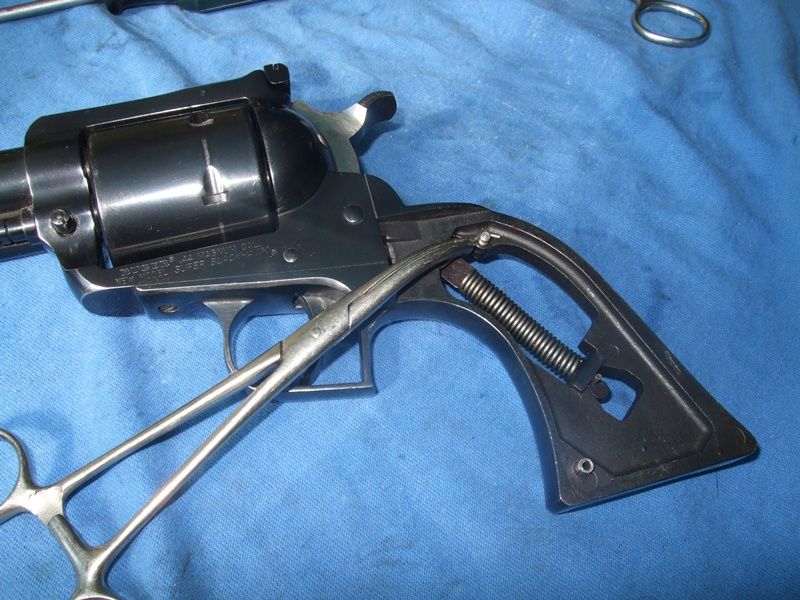 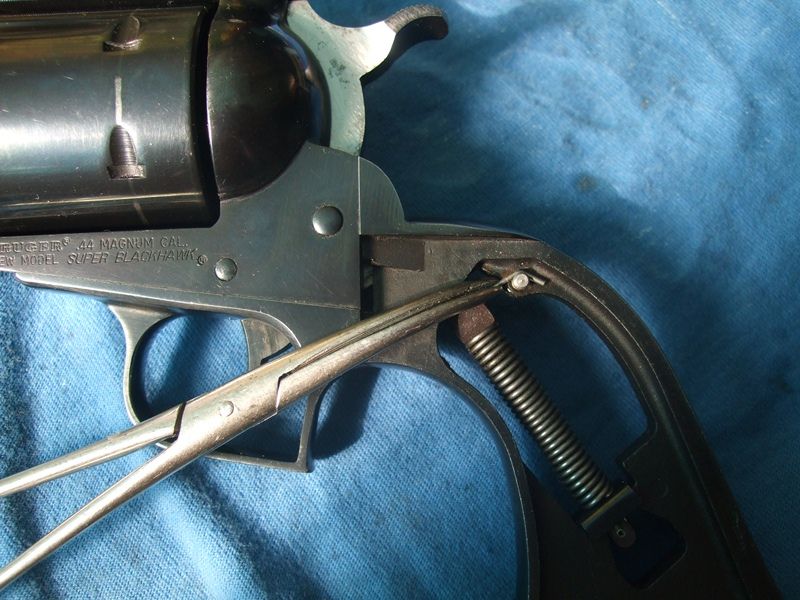 Correct screwdriver, applied with down pressure. (Unsupported cylinder frame shown for photo only.)  Note rust spot. Good reason for light lube everywhere inside.  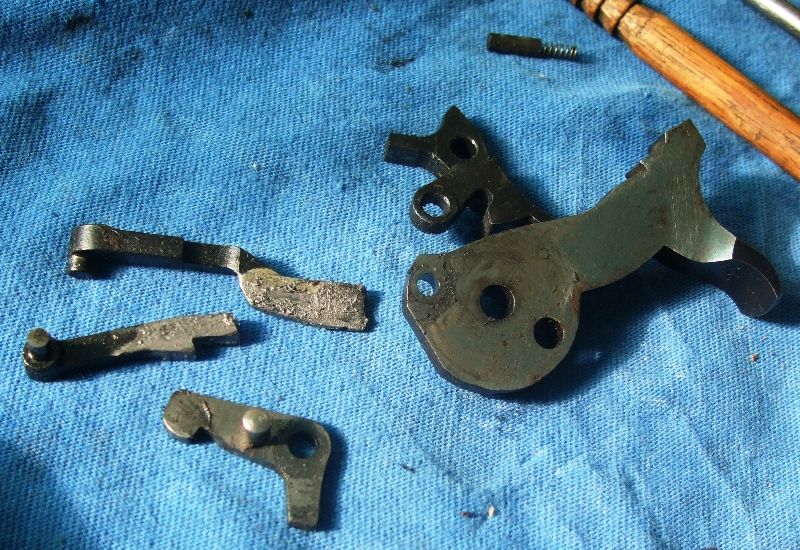 Perfect trigger work may be done with all factory parts. One leg cut from trigger spring reduces pull by nearly half. Drift punch inserted through coil may be used to bend spring----keeping both legs intact. This is at least as reliable as any aftermarket spring 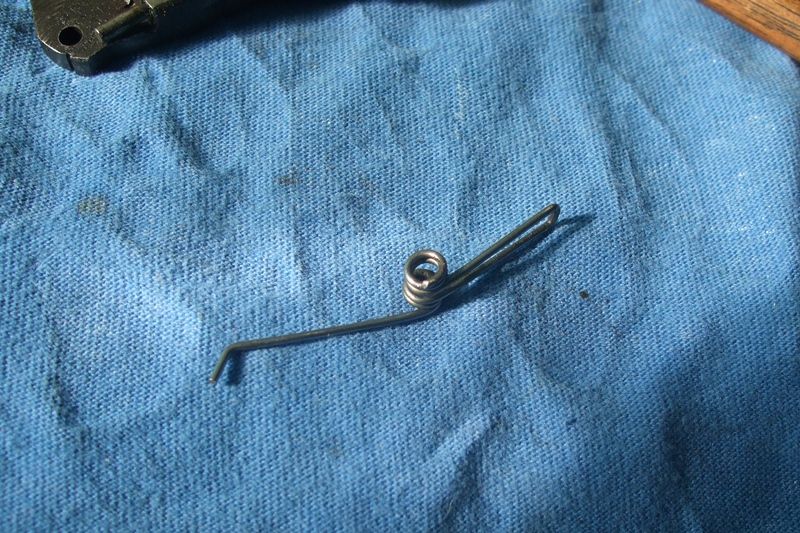 Work on hammer dog must preserve regain feature of Ruger angles. 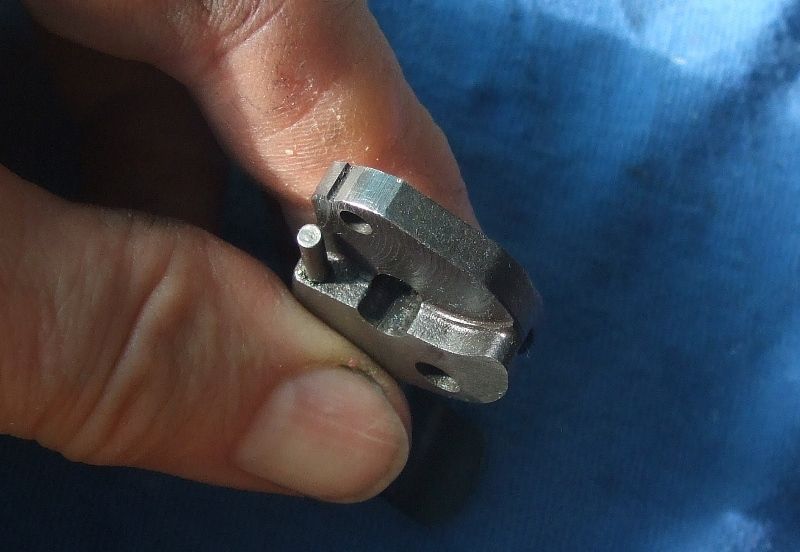 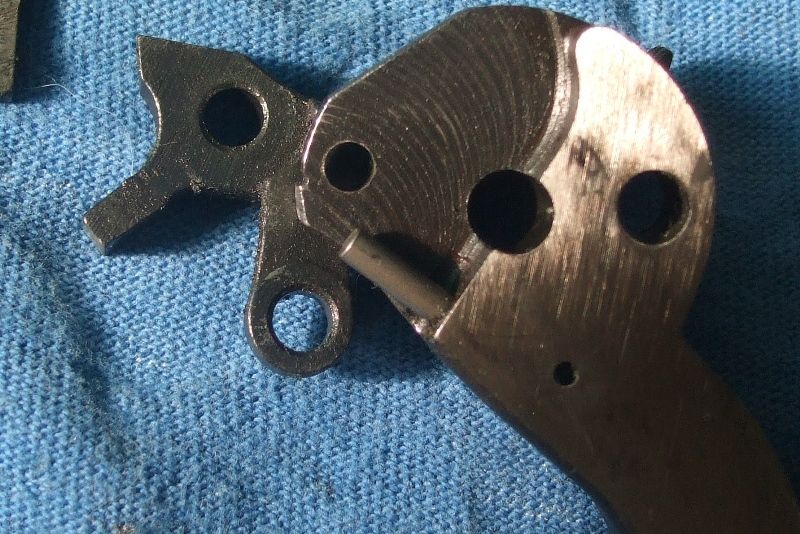 Trigger tuned for dead clear break at 1-pound with sweep-rearward follow through. Regain intact 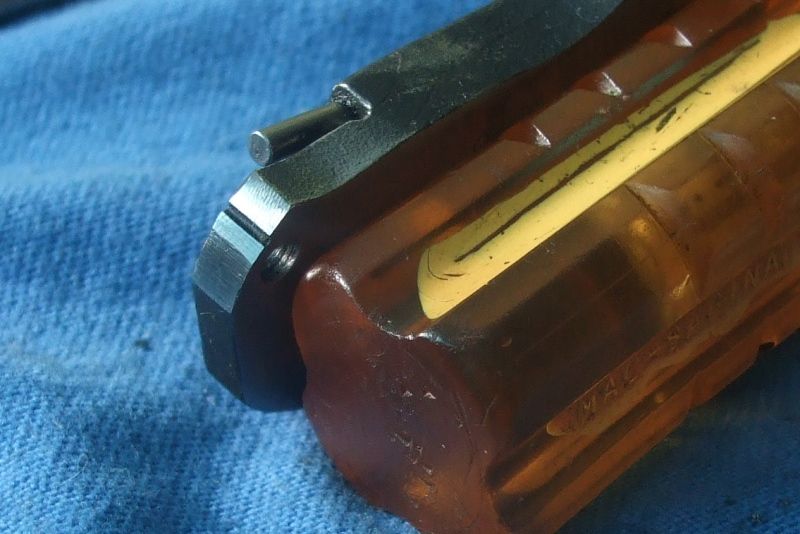 Hammer and trigger pins mounted through paper, ready to check hammer dog/trigger sear engagement. 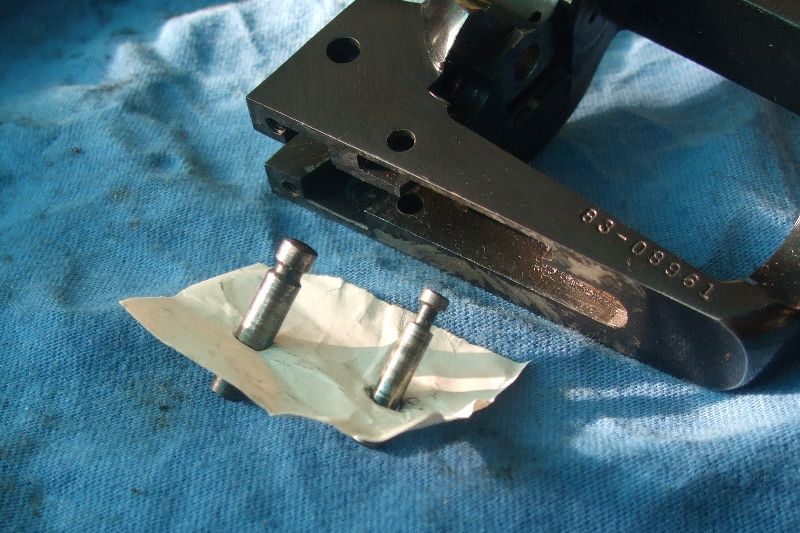 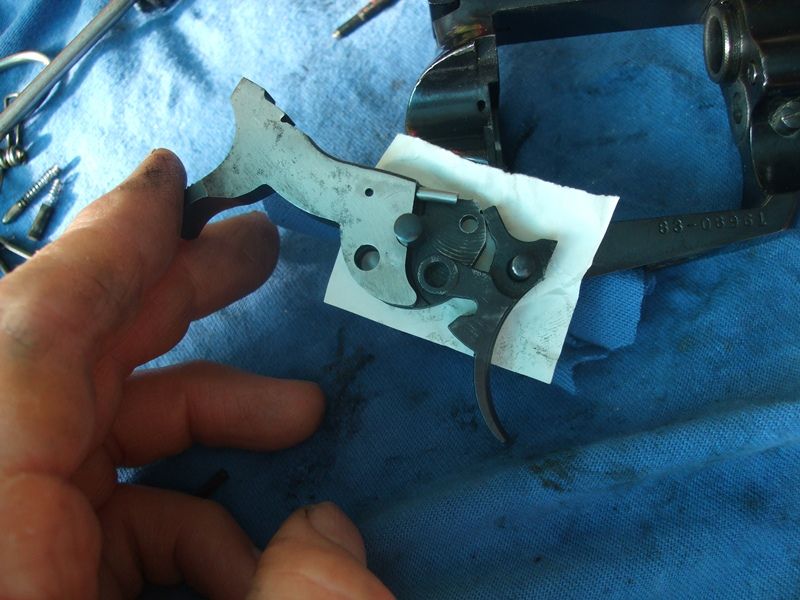 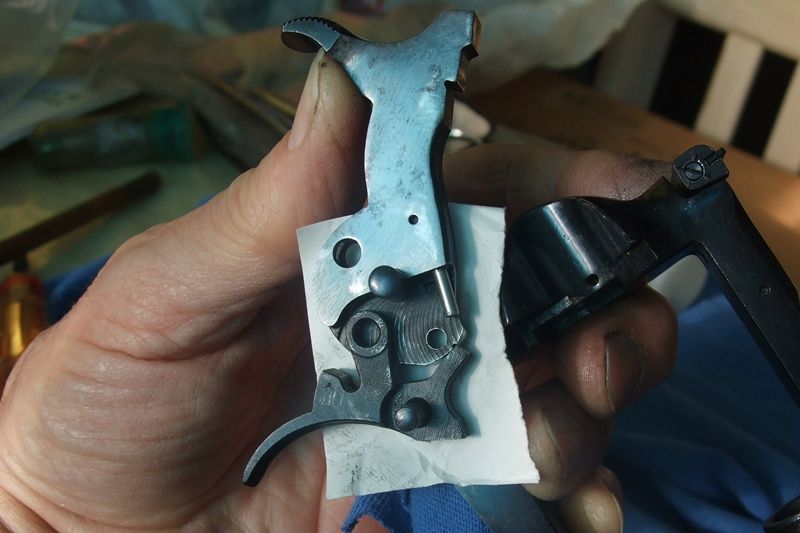 By mounting hammer & trigger outside cylinder frame, sear engagement may be checked and studied. Begin by observation of untouched factory hammer and trigger. This job is on original SRM .357 Maximum hammer & trigger.  Longest of five grip frame screws has post, which holds groove in hammer pin. Two lugs in grip frame engage cuts in cylinder frame. One (or both ) lugs is is scalloped to clear the long screw. 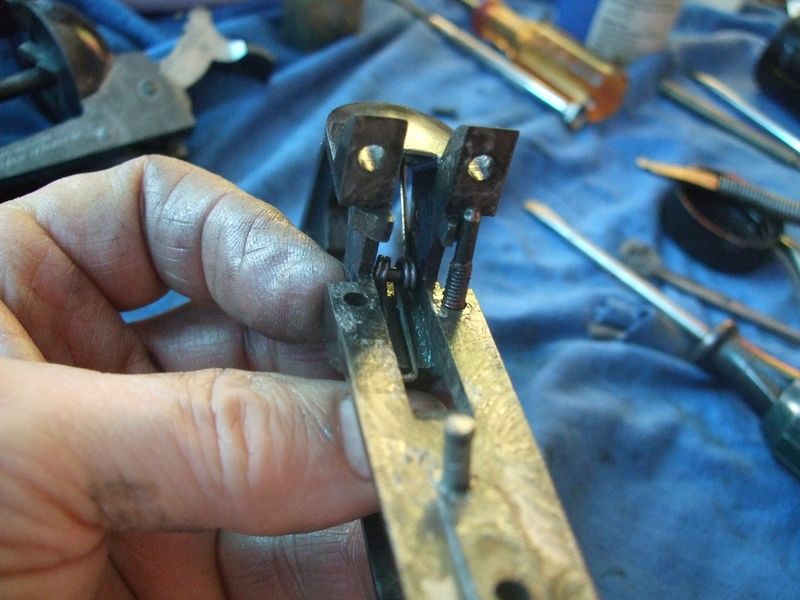 As only one lug is scalloped for the long screw on this 1979 grip frame, screw and hammer pin must match. 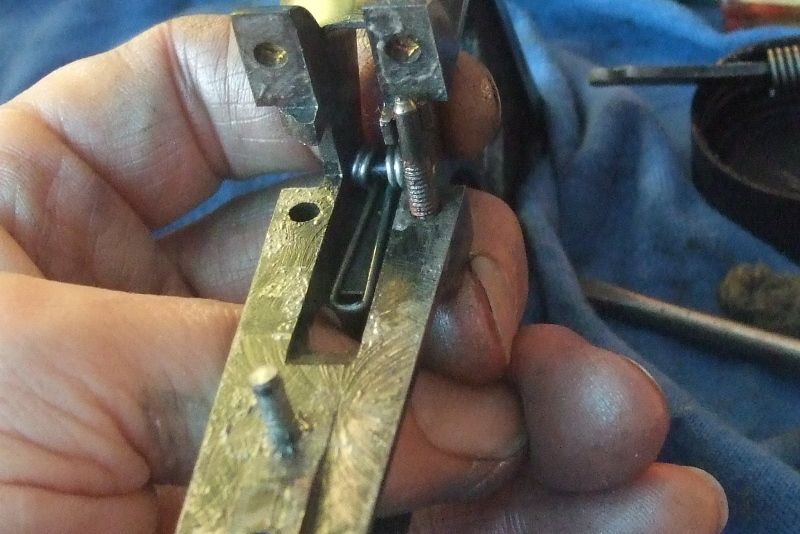 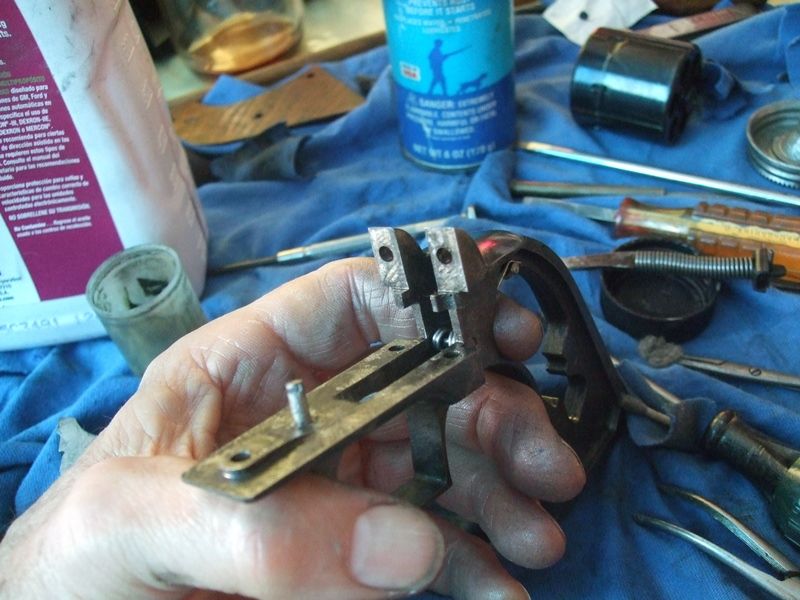 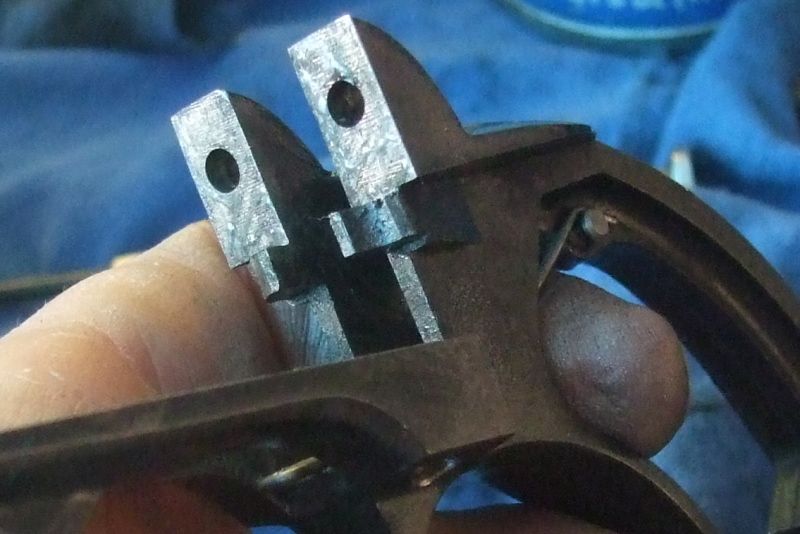 Loop of trigger spring is tucked above trigger shelf before grip frame flushes up to cylinder frame. An exposed spring----as seen in photo----is out of place. Be sure pawl spring is not pinched by back strap, and cylinder latch spring pushes cylinder latch. 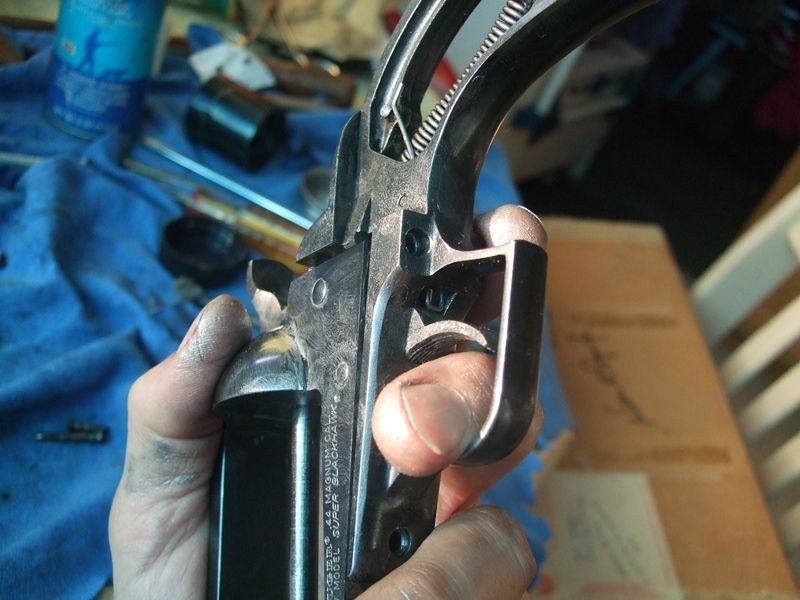 Work on hammer dog and/or trigger sear is checked on revolver by dry firing. The front trigger guard screw will secure grip frame to test letoff----a.k.a. trigger pull. To start small screws, counter-rotate until you hear or feel a light click. Turn clockwise. 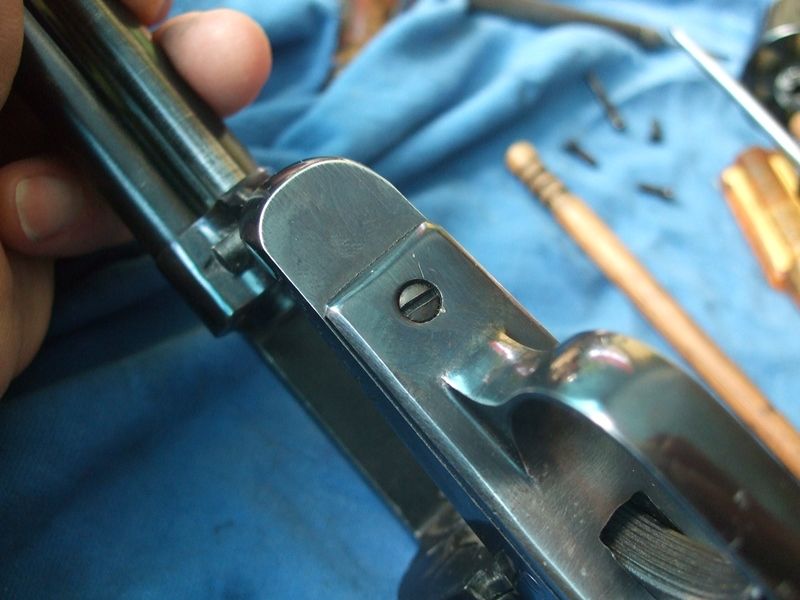 Grip frame is flushed to cylinder frame before final tightening of grip frame screws.  No matter how light a trigger is set----or squeezed----it must sweep rearward at hammer fall. 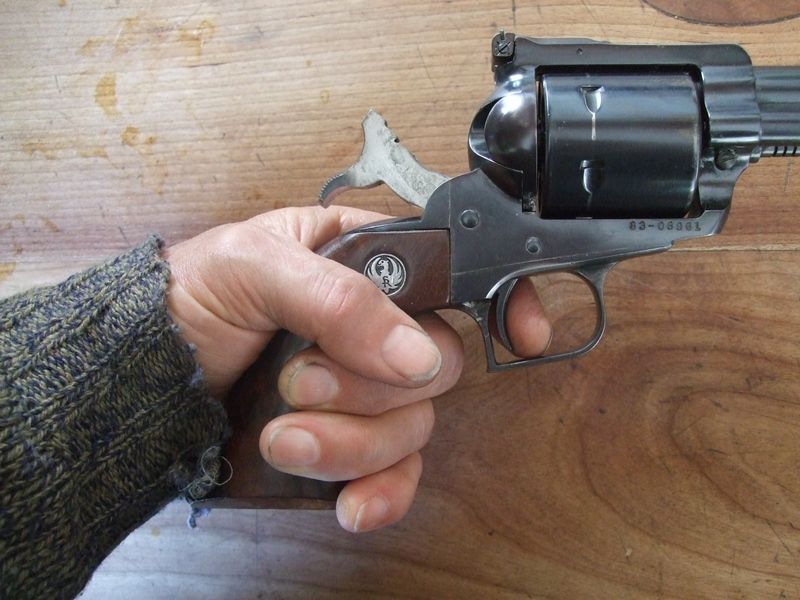 Trigger spring must be strong enough to reset trigger. 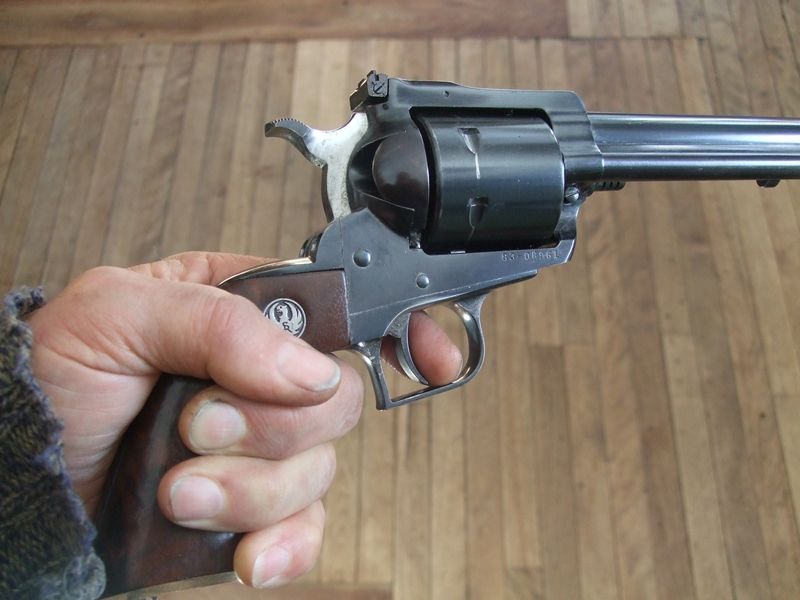 A revolver that played the game. 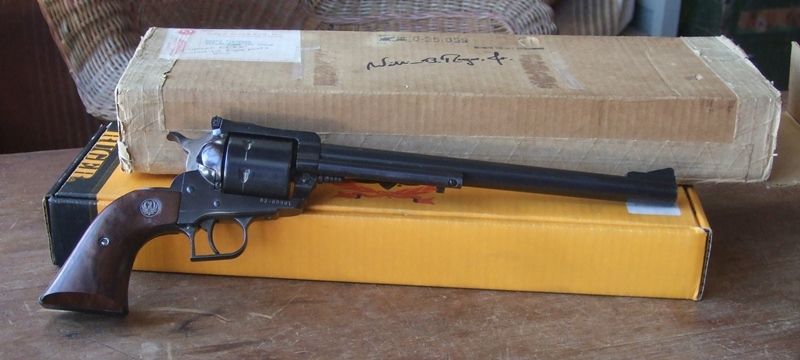 IHMSA secretary and Chosin Reservoir combat veteran Bob Barnett of Oklahoma spotted as this revolver, shooting against a wind, cleaned the rams to win the International Championship. 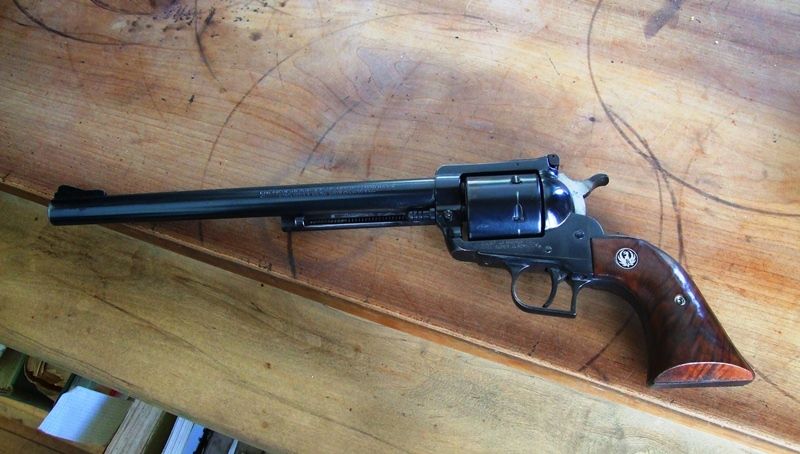 -Lee www.singleactions.com"Building carpal tunnel one round at a time" |
|
|
|
Post by bradshaw on Apr 3, 2014 10:20:53 GMT -5
Lee, again, many thanks for posting these pieces.
Trigger engagement for the SBH S410N Silhouette Super differs considerably from trigger pull shown on Ruger 03 in Vol XXXIII.
Vol. XXXIV (part 2)
SBH S410N set up for silhouette, results in dead clean break with 1-lb. letoff:
* Clean engagement surfaces. Preserve Ruger "regain" angles.
* Reduce hammer dog.
* Cut one leg from factory trigger spring.
Vol. XXXIII
Ruger 03 set up for field carry, including fast work from leather. Dead smooth take-up with noticeable movement:
* Clean engagement surfaces. Preserve Ruger "regain" angles.
* No reduction or minor reduction of hammer dog.
* Cut one leg from factory trigger spring or bend both legs.
While perfectly safe, there is not enough engagement meat on "silhouette" hammer dog and trigger sear to survive fast draw. While both triggers are set for approximately the same weight, long take-up of the 03 trigger adapts it to rigors of the trail. Both triggers sweep rearward at hammer fall, the final test of correct engagement.
Note: weight of pull is an individual matter, responsibility for which is intrinsic to the shooter.
David Bradshaw
|
|
dmize
.401 Bobcat
  
Posts: 2,832
|
Post by dmize on Apr 3, 2014 11:28:30 GMT -5
Greatly appreciated Mr. Bradshaw.
Realizing that grip preference is as subjective as favorite brand of soda,I must ask,especially after shooting my Max a bit,how did you all deal with that ^%$^#*# Dragoon grip and day filled with 44 Silhouette loads?
|
|
|
|
Post by bradshaw on Apr 3, 2014 12:49:30 GMT -5
dmize.... my middle knuckle didn't crack until Dick Casull got hold of it in 1986. I shot factory wood on the Silhouette Super through the first International Championship, continuing through the campaign to write the 40x40 record, which fell in much better weather to Dave Whitman. Looking around the firing line gave me the impression I was the last one to take the firing line with factory plow handles. That first 40x40 would have fallen months earlier, had not I slipped one over the back of my fifth chicken, wearing un-oiled cowhide gloves. Very dry day, I remember the marginal contact of my grip like it's happening right now. Enraged, I leapt off the firing line and plunged my hand into a barrel of rainwater beside the clubhouse. 39x40----on a chicken!
A fellow silhouetter told me "Pachmayr's are the cat's meow." I tried his Super, so equipped. The rubber tore at my palm. I shot upside-down tapered Ruger walnut a long time. Eventually wrapped my hand----and skull----around the Pachmayr.
Meanwhile, to shoot magnum recoil from the plow handle, I grip with the heal of my hand down around the flare of the butt. Same applies to the Casull wood and Ruger Bisley.
David Bradshaw
|
|
|
|
Post by tek4260 on Apr 3, 2014 14:00:39 GMT -5
I shot upside-down tapered Ruger walnut a long time. What do you mean by upside down taper? Thinned at the bottom? |
|
|
|
Post by bradshaw on Apr 3, 2014 22:18:32 GMT -5
tek4260.... by upside down taper I mean the traditional plow handle scales: thin at the top, thick at the bottom, which under recoil funnel the middle finger into the trigger guard.
David Bradshaw
|
|
|
|
Post by tek4260 on Apr 4, 2014 9:20:12 GMT -5
I have the habit of thinning my grips. The reason being is that I feel like I have a firmer grip the "more closed" my hand is. Sort of like gripping a baseball bat at the handle, you can hold it tighter on the smaller end than you can on the larger end. Probably has more to do with personal preference than anything scientific though.
|
|
|
|
Post by bradshaw on Apr 4, 2014 14:39:55 GMT -5
tek4260.... banging around with the .458 Winchester, you have a handle on recoil. Correct, cannot control a grip too fat for you hand. In the old IHMSA, a Production Category gun had to be stock, with no non-factory parts, except manufactured grips finished to a standard pattern. Pachmayr by far the most popular. Thus, no modification of factory grip.
When Dick Casull told me his Freedom Arms Model Model 83 had the perfect grip, I asked, "For whose hand?"
"Perfect for my hand," said Dick.
Of many things Casull got right, one was thickness at the top of single action scales.
The age of gun fighting grew up around Sam Colt's revolvers, continuing through his offspring Peacemaker. Samuel Colts' sixguns drove the sword to obsolescence. Intuition tells me the flared grip helped keep the reviolver in hand on horseback. And to facilitate and therefore speed draw from a deep holster. For original reasons, the flared butt is an asset.
David Bradshaw
|
|
|
|
Post by squawberryman on Apr 5, 2014 7:18:36 GMT -5
Mr. Bradshaw, it would appear in the pics that your hammer does not have the typical discoloration associated with heat treating. Seems like whenever someone posts blueprints of Harton builds or also other places, references are made to heat treating the innards. Any thoughts on this? Also, As I look at a disassembled Super Single Six and the dogs, I don't see where a hammer forward situation could exist after pull. Can you elaborate (pref with pics)? I hope the mechanical novices are getting as much out of this thread as I am, I'll be making a thread of my trigger job with a great tool soon.
|
|
|
|
Post by bradshaw on Apr 5, 2014 7:59:46 GMT -5
squawberryman.... "I don't see where a hammer forward situation could exist after pull..."
Believe you meant to say "... don't see where a TRIGGER FORWARD situation could exist after pull... " And you correctly infer, a photo missing from the sequence----which would show hammer down and trigger at very rear of trigger guard.
This is what happens when trigger job preserves the REGAIN angles designed by Ruger to provide a slight hook quality to engagement. This is true no matter how light the trigger and how gentle the gentle the squeeze:
* Trigger sweeps rearward at hammer fall.
* As trigger is released, trigger resets to forward position.
more shortly,
David Bradshaw
|
|
|
|
Post by bradshaw on Apr 5, 2014 13:06:05 GMT -5
squawberryman....
One sure method to check for correct single action sear engagement following a trigger job----or butchery----is to squeeze trigger ever so softly, until hammer fall. With correct engagement, the trigger continues rearward. This applies to the single action on a DA revolver, just as it applies to a single action revolver. A fugitive trigger job or fugitive engagement makes actual letoff pressure lighter than pull weight. The trigger spring kicks the trigger forward at release of the hammer. With a DA revolver, the trigger catches the double action fly, stopping hammer fall.
With a transfer bar system----single or double action revolver----the transfer bar drops below the firing pin as the trigger kicks forward.
For reliability and trigger reset (rebound), single action letoff should be no lighter than:
* Ruger single action----one pound.
* Redhawk----3.25 lbs.
* S&W----3 lbs.
* DWA----1.5 lbs.
* Colt Python----2 lbs.
Of these figures the most specific is 3-1/4 lbs. for the Redhawk.
Heat Treatment
Ruger hammers and triggers are heat treated, as are the cylinder frames of all revolvers, cylinders, and a few other parts I may have left out. At least until the death of Bill Ruger and retirement of Bill Ruger, Jr., Ruger, it is my understanding that Sturm, Ruger used no surface hardening. Hardened parts are through-hardened.
Have no knowledge of hardening or heat treatment of Ruger hammers and/or triggers outside the factory.
Smith & Wesson tried unsuccessfully to make stainless hammers and triggers for stainless revolvers. The parts didn't hold up. S&W resorted to standard----drop forged carbon steel----case hardened hammers & triggers, which were then hard chrome plated, or "flash chromed."
David Bradshaw
|
|
|
|
Post by bradshaw on Apr 5, 2014 13:49:15 GMT -5
More on trigger quality...
* Keep stones away from drop-forged, case-hardened, S&W hammers and triggers.
* Never push a cocked hammer to test engagement. Any baboon can ruin a good trigger pull. Such a stunt is little more than exercise for a weak mind and heavy thumb. I have seen so-called safety inspectors do this at matches. It is arbitrary and devoid of measure, and will shortly turn correct sear engagement into fugitive engagement. The test for correct engagement finds the trigger sweep rearward at hammer fall.
* Proper sear engagement on revolver or auto pistol holds up in presence of lubrication & absence of lubrication.
* I have tried to do trigger jobs on revolvers where variation in molecular structure of the sear was evident. Inferior hardware----soft metal with hard inclusions.
* If there are better hammers and triggers than original Ruger parts, I have found NO need for them. Same applies to drop-forged, case-hardened S&W parts----just don't stone through the VERY THIN hardness layer.
David Bradshaw
|
|
|
|
Post by jayhawker on Apr 5, 2014 22:08:34 GMT -5
I can attest to Ruger SS SA hammers being hard. I was going to lighten the hammer by drilling holes through it where they would not show. My drill bit wouldn't but scratch it. Suspecting the bit, I bought a new carbide bit, with the same results.
|
|
|
|
Post by tek4260 on Apr 5, 2014 23:17:46 GMT -5
I can attest to Ruger SS SA hammers being hard. I was going to lighten the hammer by drilling holes through it where they would not show. My drill bit wouldn't but scratch it. Suspecting the bit, I bought a new carbide bit, with the same results.  Glad to hear that I am not the only one....... |
|
|
|
Post by bradshaw on Apr 7, 2014 15:34:23 GMT -5
squawberryman.... a gunsmith who reworks the hammer and/or trigger, using a torch or welding----annealing in the process----may very well re-heat treat the parts. This could explain discoloration. Otherwise, I see no reason to "improve" Ruger metallurgy, which continues to stand tall in the test of time.
David Bradshaw
|
|




















































